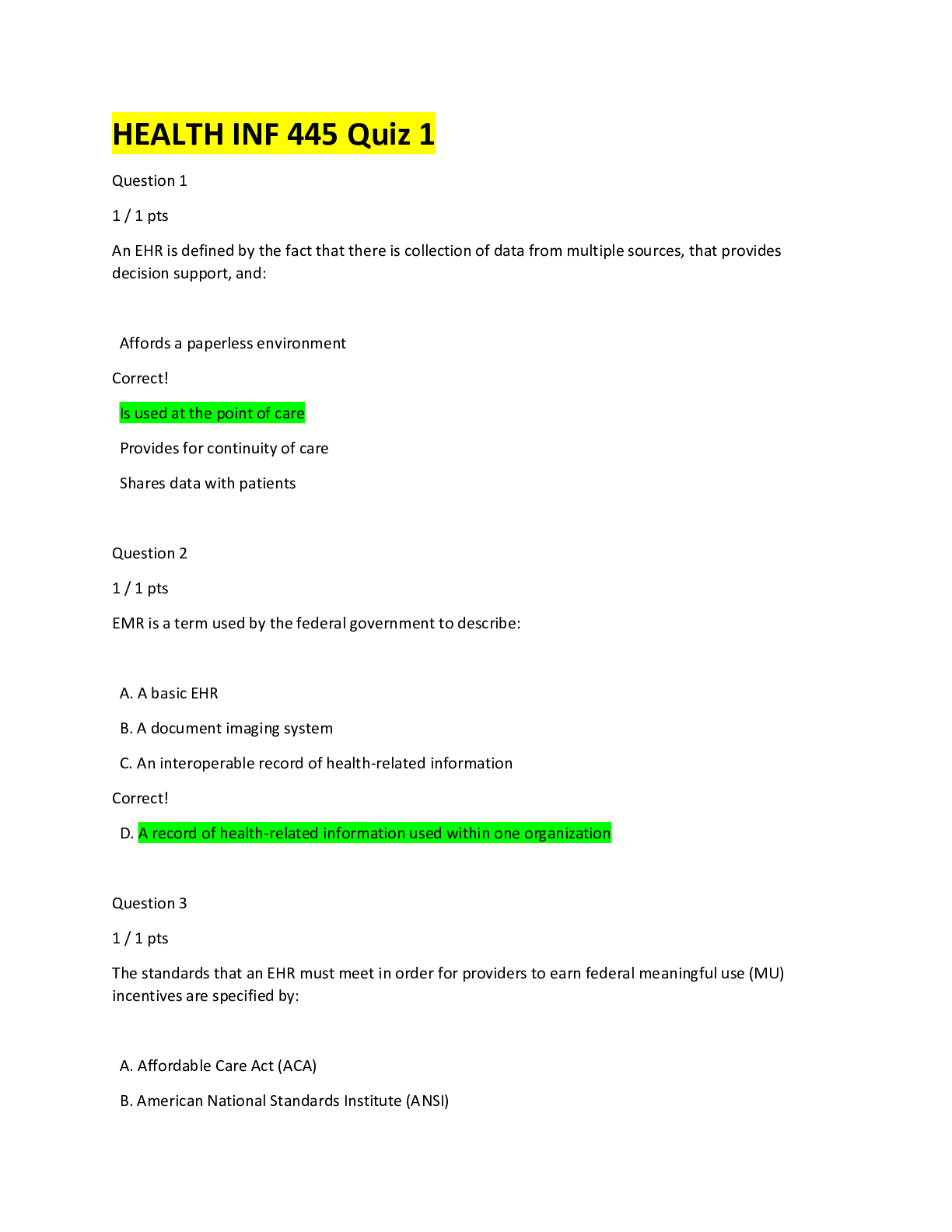General Questions > QUESTIONS & ANSWERS > CPCE Exam Top Questions and answers, 100% Accurate, graded A+ (All)
CPCE Exam Top Questions and answers, 100% Accurate, graded A+
Document Content and Description Below
CPCE Exam Top Questions and answers, 100% Accurate, graded A+ Empirically validated Treatment or Empirically Supported treatment - ✔✔-When counselors do integrate research into practice. Cor... relation - ✔✔-Correlation is simply an association. It is not the same as causality. The correlation between people who have an umbrella open and rain is very high, but opening your umbrella does not cause it to rain. Three types of correlations - ✔✔-Go from negative 1 to 0 to positive 1. Zero means no correlation while positive 1 and negative 1 are perfect correlations. A negative .5 is not higher than a correlation of -.5 In fact, a correlation of -.8 is stronger than a correlation of .5. A positive correlation: when x goes up, y goes up. For example, when you study more, your GPA goes up. A negative correlation: when x goes up y goes down. For example, the more you brush your teeth, the less you will be plagued by cavities. Quantitative research - ✔✔-when one quanitifes or measures things. It yields numbers. Qualitative research - ✔✔-When does research does not use numberical data Bubbles - ✔✔-When research has flaws What is a true experiment? - ✔✔-Two or more groups are udes. What is random sampling? - ✔✔-People are picked randomly and placed in groups using random assignment. Systematic sampling - ✔✔-where every nth person is chosen can also be used howere, researchers stillprefer random sampling and random assignment What is quasi-experimental research? - ✔✔-When the groups are not picked at random or the researcher cannot control the IV then it is a quasi rather than a true experiment. quasi-experimental research does not ensure causality. What is the independent variable - ✔✔-The experimental group gets the IV and it is known as the experimental variable. what is the DV or dependent variable? - ✔✔-the outcome data in the study is called the DV. If we want to see if eating carrots raises one's IQ then eating carrots is the IV while the IQ scores at the end of the study would be the DV. Type I alpha error - ✔✔-When a researcher rejects a null hypothesis that is true. Type II beta error - ✔✔-When a research accepts null when it should have been rejected. What is significance levels in social science? - ✔✔-.05 or less (.01 to .001) The signifcance level gives you the probability of a type 1 error. N=1 - ✔✔-a single subject design or case study and thus does not rely on IV, DV, control group, ect. Case studies are becoming more popular. Demand characteristics - ✔✔-evident when subjects in a study have cues regarding what the researcher deires or does not desire that influence their behavior. This can counfound an experiment rendering the research inaccurate. An obtrustive or a reactive measure - ✔✔-if subjects know they are being observed. Observers' presence can influence subject's behavior rather than merely the experimental variable or treatment modality. Unobtrusive measure - ✔✔-When subjects are not aware that they are being measured. Internal vailidty - ✔✔-when an experimental has few flaws and thus findings are accurate. The IV caused the changes in the DV, not some other factor (known as confounding extraneous variables or artifacts). When internal vaility is low the researcher didn't measure what he thought he measured. External validity - ✔✔-it is high when the results in a study can be generalized to other settings. A t test - ✔✔-a popular parametric test for comparing two means. ANOVA or analysis of variance - ✔✔-Also called a one-way ANOVA. used when you have two or means to compare. The t test and the ANOVA are parametric measures for normally distributed populations. The ANOVA provides F values and the F test will tell you if significant differences are present. MANOVA - ✔✔-Used when you are investigating more than one DV> A factorail analysis of variance - ✔✔-When you are investigating more than one IV/experimental variable (if you have two IVs it would be called a two-way ANOVA three IVs a three way ANOVA.) Chi square - ✔✔-if the population is not necessarily normal then this nonparametric test is used. or a Kruskal-wallace can be used. Ex post facto or causal comparative design - ✔✔-if the researcher did not manipulate the variable and you are looing at after the fact data, the the research is not a true experiment. Descriptive statistics - ✔✔-statistics that describe central tendency like the mean, median, the mode, the range, quartiles, the variance and the standard deviation. Statistical analyses - ✔✔-include correlation, coefficients, t tests, ANOVAs, Analusis of Covariance, Chi square, Krushal Wallis Cohort studies - ✔✔-examine a group of people who have something in common Longitudinal research - ✔✔-tkaes place when the same individuals are evaluated over a period of time. Cross-sectional research - ✔✔-Relies on observation or data from a given point in time. Formative evaluation - ✔✔-takes place during treatmetn or while a program is going on while summative or outcomes evaluations occurs at the end of a program or treatment (e.g. after the final session of counseling) Between groups design - ✔✔-Uses different subjects in the different groups (e.g. one group of subjects for the control group and another group of subjects for the experimental group) Within groups repeated measures design - ✔✔-uses the same subjects for the control condition and then at a different time for the IV/experimental conditions. Scope of practice - ✔✔-implies that you only practice if you are adequately trained in a given area or with a given population. A counselor's duty to warn - ✔✔-Based on the Tarasoff case. This principle now states that if a client is going to harm him or herself, somebody else, or both, you will break confidenctiality and contact the appropriate people (the police, the target person) to ward off this tragedy. Dual Relationship - ✔✔-Could also be called multiple relationships on the exam. This concept implues that you are a person's helper but you also have another significant relationship with that person (maybe you are dating them or perhaps they are a relative or business partner) Such relationships get in the way of objectivity and should be avoided whenever possible unless the relationship is beneficial to the client. Priiviledged communications - ✔✔-Set by the state, law priviledged communication asserts that you cannot reveal what a client said in session in court unless the client allows you to do so. There are exceptions to this such as child abuse, suicide, homicide, and supervisory sessions or if a lawsuit is filed against you. You should never release information about the client outside of court (unless it is the exceptions just mentioned) unless the client signs a release of information consent form. Remember to disguise the identity of your clients when doing research, training or in a work for publications. Standardized tests - ✔✔-uniform procedures for scoring administration. In addition, these instruments have validity and reliability and norm data which has been investigated and analyzed. The Mental Measurements Yearbook and Tests in Print - ✔✔-From the Buros Institute provide counselors with information on thousands of tests. Online versions are now available. Approximately 2,500 of the tests have been critically analyzed by Burros. What are raw scores - ✔✔-Unaltered scores. Then can be converted to standard scores (e.g. t scores, z scores, percentile rank, standard deviation or stanine) so that the scores related to the normal bell curve. Range - ✔✔-The range is the highest score minus the lowest score. Percentile rank - ✔✔-tells the counselor the percent of scores equal to or below the score you are investigating. Hence, a client who is at the 75th percentile scored equal to or better than 75% of the people who took the exam. It does not necessarily imply that he or she got 75% of the answers correct since a score of 20% correct might be higher than 75% of the examinee What are the three measures of central tendency - ✔✔-mean, mode, median What is the mean - ✔✔-an arithmetic average What is the mode - ✔✔-the most frequently occuring score or category the median - ✔✔-the middle score when the data are ranked from highest to lowest. What is a normal curve - ✔✔-They all have the same point in the center of the bell shape If the curve tail is to the left, the curve is what - ✔✔-Negatively skewed If the curve tail is to the right, the curve is what - ✔✔-Positively skewed What is standard deviation - ✔✔-A measure of variability or dispersion of score. A standard deviation of 1 is a z score or standard score of one. A standard deviation of -2 is a z score of negative 2 What is a t score - ✔✔-Have a mean of 50 and the standard deviation is 10 What are the three areas under the normal curve - ✔✔-68% plus or minus 1, 95% plus or minus 2, 99.7% plus or minus 3. This is called empirical 68-95-99.7 normal curve Validity - ✔✔-is the most important property of psychology test. Reliability - ✔✔-is the test consistent? Will it give the similar results if we administer it again and again. If am IQ test yields a score of 100 todayand 130 for the same client tomorrow it is not valid. What is the rule for validity and reliability - ✔✔-a reliable test is not always valid, but a valid test is always reliable. What is interrater relaibility - ✔✔-Describe the consistency of two or more raters. If two counselors read the same test reports and come up with the same diagnosis, then interrater relaibility or agreement is high. IF they come up with different diagnoses then it is low. How is a test normed - ✔✔-It is normed on the majority culture is not appropriate for cultural minorities since it is misleading and could cause discrimination Can test give a false positive or a false negative? - ✔✔-Yes What does an aptitide test do? - ✔✔-Predicts potential. For example a high score on an aptitude test for music doesn't imply that you are a great musician but that with the corect training and practice you could excel in this area. What does an achievement test do? - ✔✔-Gives you the current accomplishment, what has been learned or the level of performance achieved up to the point in time. (e.g. she is reading at the sixth grade level) Intelligence tests or IQ - ✔✔-Wechsler or the Binet attempt to measure mental abilities. IG are very controversial and have been a source of debate for counselors. Power Test - ✔✔-(slow performance) is not a factor like it is in so-called speed test. Projective tests - ✔✔-There is no correct answer. The client merely looks at an ink blot, a vague picture, or an incomplete sentence. The client's answer is assumed to be a projection of his or her personality. Thus two clients look at the same Rorschach Ink blot card or TAT picture and see something totally different. Interrater relaibility - ✔✔-Scoring projective tests is subjective. Thus one rater could score it differently than another rater. Regression to the mean - ✔✔-states that if a client scores exceptionally low or exceptionally high on a test, then the client with the low score will go up on the next administrion; while the client with the high score will go down toward the mean or average. Chance factors or everyday luck probablyt influenced the first score. Computer Assisted Career Guidance what is it? examples - ✔✔-SIGI plus or Discover. Screen the client to make certain this modality and computer program is approrpiate. Give the client an orientation to describe the pros and cons of the system. Follow-up to make certain an appropriate plan of actionis evident. What is the Dictionary of Occupational titles (DOT) - ✔✔-List over 20,000 jobs titles. It replaced the O NET. GOE or Guide for Occupational Information - ✔✔-Uses 14 interest areas (e.g. plants and animals or education and social services) to help fine tune career searches. OOH or Occupational Outlook Handbook - ✔✔-Gives job trend for the future and salaries and can be accessed over the Internet What was Richard Bolles's book? - ✔✔-What Color is Your Parachute? What is the Hidden Job Market - ✔✔-80% of all job are not advertised and this job seekers need to network. Underemployment - ✔✔-Occurs when a person takes a job below his or her level of skill, expterise, and training (e.g. PhD who works in an entry level fast food position) Dislocated worker - ✔✔-A term that describes a person who is unemployed due to downsizing a company relocationm or the fact that the company closed the business. Displaced homemaker - ✔✔-Describes women who enter or reeneter the workforce after being at home. This often occurs after a divorce or the death of a partner or spouse. Outsourcing - ✔✔-Tkaes place when U.S. companies rely on labor from another country in order to save money. What is a central tendency bias - ✔✔-When a supervisor erroneously rates the majority of workers as average. The recency effect - ✔✔-Occurs when the rating reflects primarily the worker's recent performance (rather than the entire rating period) since this effect suggests we remember things the best that are presented last. Halo effect - ✔✔-A supervisor generalizing about an employee based on a single characteristic (e.g. giving a worker who is kind a higher rating than a worker who is just as good but isnt kind) Positive and negative halo effects are possible. What is trait and factor theory in career counseling and who came up with it? - ✔✔-Frank Parsons (father of guidance) he was the author of choosing a vocation. A client needs to know his or her personal attributes and interests or traits; Appropriate occipations should be investigated; match the client's traits to the occupation. E.G. Williamson twist on trait and factor theory-six steps - ✔✔-analysis, synthesis, diagnosis, prognosis, counseling and follow up. The assumption is that there is a single best career goal for everyone. Most experts disagree. What is Ann Roes psychodynamic needs approach to career counseling - ✔✔-Roes is like Rogers in person centered environment for careers. emphasized early child rearing practices influence later career choices. Jobs meet our needs determined by our childhood satisfaction and frustrations. Occupations are categorized by six levels and eight fields. Our orientation toward or awar from other people can influence our career choices. Who developed (development theory for careers) and what is it? - ✔✔-Ginzberg, Ginsburg, Axelrad, and Herma. Three periods: fantasy (birth to 11 in which play becomes work oriented; tenetative (ages 11 to 17); and realistic (17 and up) What is the career developmental approach? - ✔✔-David Tiedeman and Robert O'Hara. In their model career development is commensurate with psychosocial development linked to Erik Erikson's stages. What is the Life Rainbow? - ✔✔-Donald Super. Emphasizing the role of the self-concept in career and vocation choice. People seek career satisifaction through work roles in which they can express themselves and further implement and develop their self concept. What are the Five Life and Career Developmental Stages of Super - ✔✔-Growth Exploration, Establishment, Maintenance and Decline What are the Tasks of Career Development - ✔✔-Crystalization, Specialization, Implementation, Stablization, Consolidation What was John Holland's personality typology theory? - ✔✔-6 types: realistic, investigative, artistic, social, enterprising and conventional. (RIASEC). Also known for self-direct search tool, my vocational situation and vocational preference inventory. Social Learning Theory career counseling? - ✔✔-Krumbolts, Mitchell and Jones-Career decisions are based on it. Four factors impact career choice: genetic factors and special abilities; the environment and special events; learning experiences; and task approach problem solving skills. What is circumscription and compromised in career counseling? - ✔✔-Linda S. Gottfredson. Self concept and self efficacy in determining vocational choices. Emphasized circumscription (the process of narrowing the acceptable alternatives) and compromise (realizing that the client will not be able to implement their most preferred choices.) the client adjusts aspriations to accommodate such things as hiring practices, family obligations or educational programs. People sacrifice interests rather than sex-type of prestige. What is Social Cognitive Career Theory - ✔✔-By lent, Brown and Hackett. Helps complement other theories emphasizing the role of self-efficacy and cognitive processes. What are the six types of groups - ✔✔-psychoeducational/guidance groups. counseling groups, group therapy, t-groups, structured groups, self help groups/mutual groups/support groups What is psychoeducation/guidance groups - ✔✔-Provide members with information relevant to their situation Counseling groups - ✔✔-Focus on conscious issues related to personal growth and development Group therapy - ✔✔-A term coined by Jacob Moreno who founded psychodrama. Can focus on unconscious material, the past and personality change. T-group - ✔✔-training groups are often intended for business or personal motivation structured groups - ✔✔-are centered around certain issues such as shyness or how to prepare for a job interview Self-help groups/mutual help or support groups - ✔✔-Not led by a professional. These groups have been dubbed as support groups and those that follow the AA model are often called 12 step groups. What is autocratic or authoritarian group style - ✔✔-advocates making decisions FOR members. It is appropriate during a crisis or when a quick decision is in order but in most situations it will foster resentment. Laissez faire or hands off style what is this group style? - ✔✔-Here the leader has little involvement. This approach is appropriate when all members are very commited to a group outcome or goal. Democratic approach group style - ✔✔-allows input from members but allows group members to have input into their decisions. This is generally the best style. Speculative leaders group style - ✔✔-Often seen as charistmactic. they rely on their personal power and charisma to move the group in a desirable direction. They are often adored and group members look up to them, though they are not peer oriented. Confrontive leadership style - ✔✔-The facilitator reveals the impact that his behavior has on himself as well as the impact that other group members have on him. Which group style is best? - ✔✔-Research has not shown that the speculative style is superior to the confrontive style or vice verse. Whatever style the leader utilizes, he or she must not impose his or her personal values on group members. How big should groups be?> - ✔✔-Ideal sixe is 5 to 6 to 8 members, with 8 being preferable. Groups that are conducted for a long time (6 months or so) can function effectively with up to 10 members. Size should be smaller with children. What is the difference between and open and a closed group? - ✔✔-An open group is new members can join after the group begins. A closed group is no new members can join after the group begins. What are the rules with leaders? - ✔✔-A group can have a single leader or be led by coleaders. The advantage of coleaders: having two role models (perhaps two genders) more feedback, one leader can deal with the client if there is transference and two leaders can better see what is transpiring in the group. Disadvantages: leaders can work at cross-purposes, may have conflicting models of therapy, could be in a power struggle and may each decide to charge the client a different fee. What are the stages of group? - ✔✔-The initial stage, the forming stage or the orientation stage-This is called the get acquainted stage. The 2nd stage is the transition, conflict or the storming stage. This stage is characterized by power struggles for control and resistance. The 3rd stage is the working, productive, performing or action stage, Here the group works toward goals in a cohesive manner; the termination, closure, completion or mourning and adjourning stage. Members must deal with saying goodbye. What are Yalom's 11 reasons that groups work so well? - ✔✔-Altruism-giving help to others gives members of sense of wellbeing. Universality-simple the notion that you are not the only one in the world with a particular problem. Installation of hope-In plain everyday English, the members expect the group to work. Catharsis-Talking about your difficulities is beneficial. Group cohesiveness: A sense of we-ness Imitative behavior-We learn by watching others. In this situation, the members copy or model the leader and the other members. Family reenactment-The group helps abet family of origin issues and feelings and the group allows you to work through them. Imparting information: This could be advice or even psychodynamic insight. Interpersonal learning: Members receive feedback regarding how their behavior affects others. Socialization techniques: such as feedback and instruction are helpful. Existential factors: Discovering that life can have meaning even if it is seemingly unjust or unfair at times. Who was Nathan Ackerman - ✔✔-Family psychodynamic or psychoanalystic aproach to family counseling Crisis intervention - ✔✔-used for persons who are experiencing an expected normal reaction to stress. Therapy on the other hand, is aimed at reducing absnormal and pathological behaviors and symptoms. What is Milan Model know for? - ✔✔-a treatment team with a one-way mirror. What is consultation? - ✔✔-Occurs when you voluntarily assist a counselor or counselors who will be helping clients. Gerald Caplan - ✔✔-the father of mental health consultatio [Show More]
Last updated: 1 year ago
Preview 1 out of 32 pages
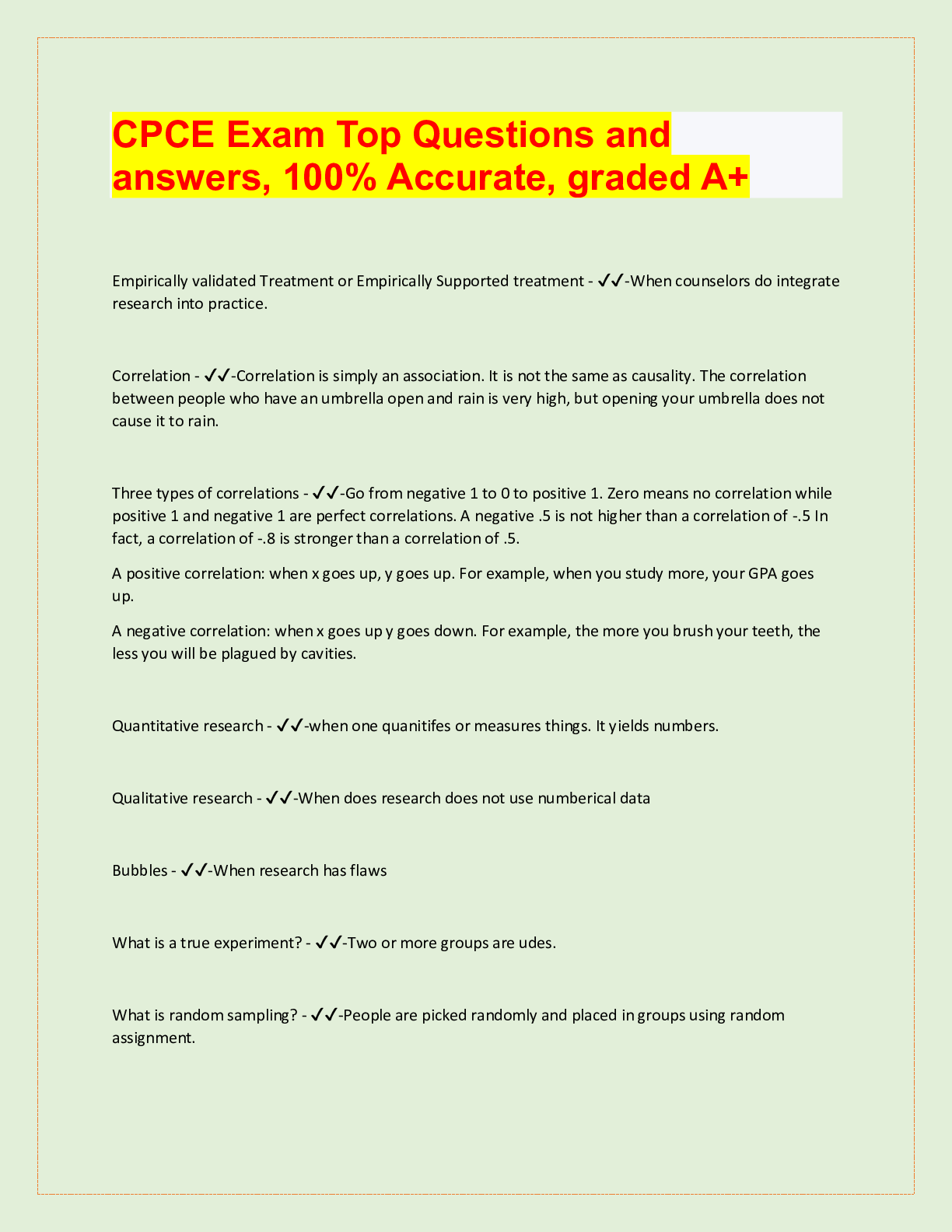
Also available in bundle (1)

CPCE/NCE Exam BUNDLE, QUESTIONS AND ANSWERS, VERIFIED.
CPCE/NCE Exam Prep, question sections coverage, graded A+, latest update. ALL 34 VERSIONS. PASS YOUR EXAMS WITH THIS BUNDLE. 47 VERSIONS
By Topmark 1 year ago
$38
34
Reviews( 0 )
Document information
Connected school, study & course
About the document
Uploaded On
Mar 12, 2023
Number of pages
32
Written in
Additional information
This document has been written for:
Uploaded
Mar 12, 2023
Downloads
0
Views
90






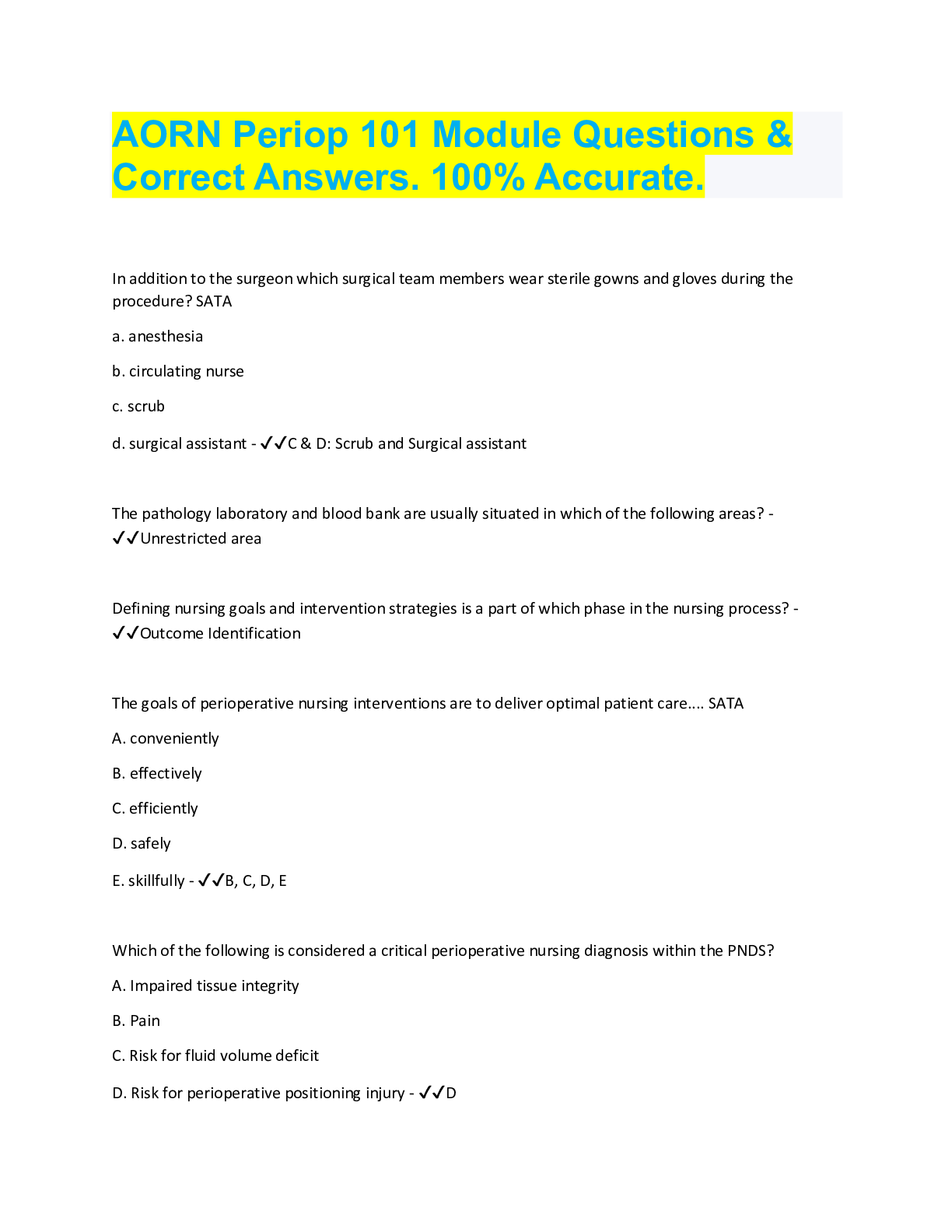





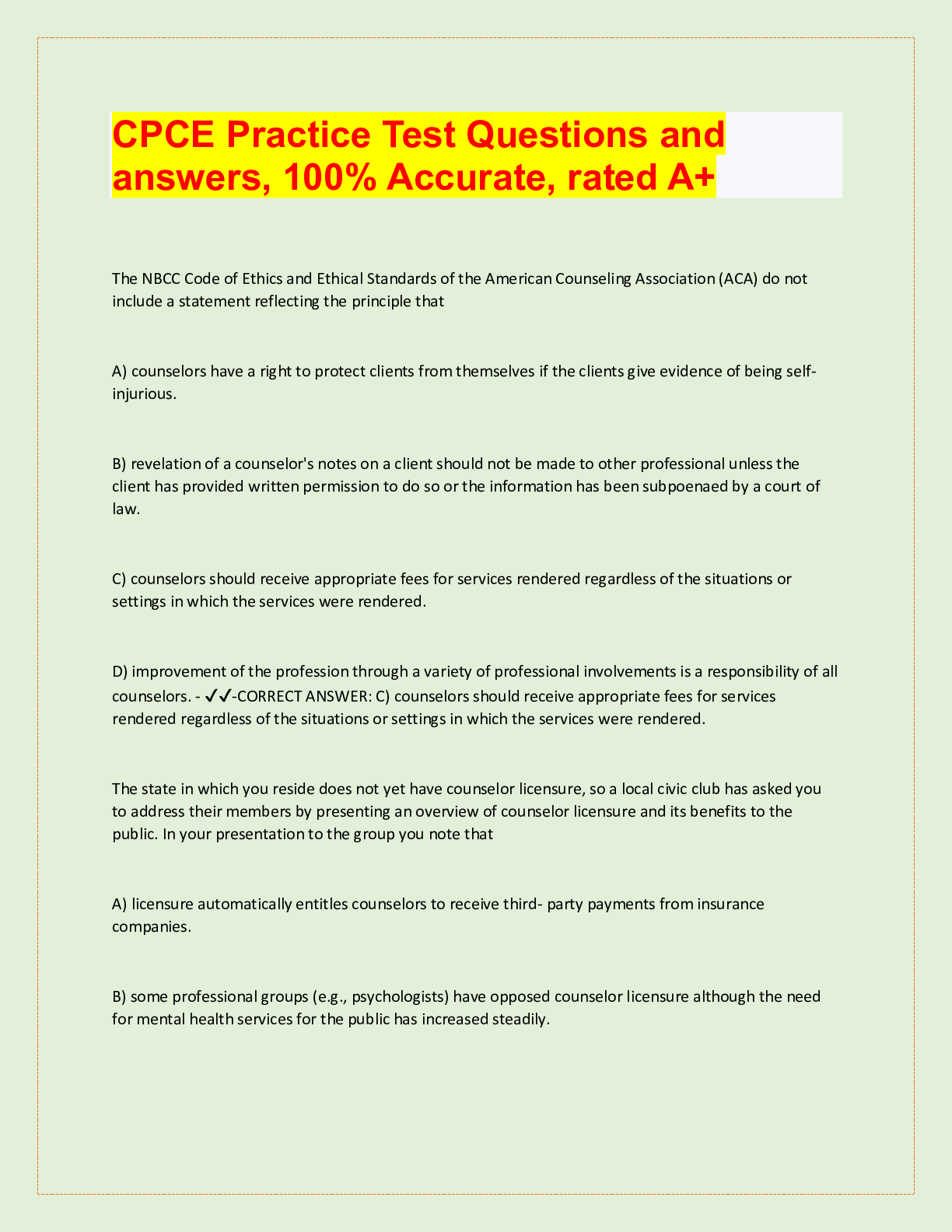


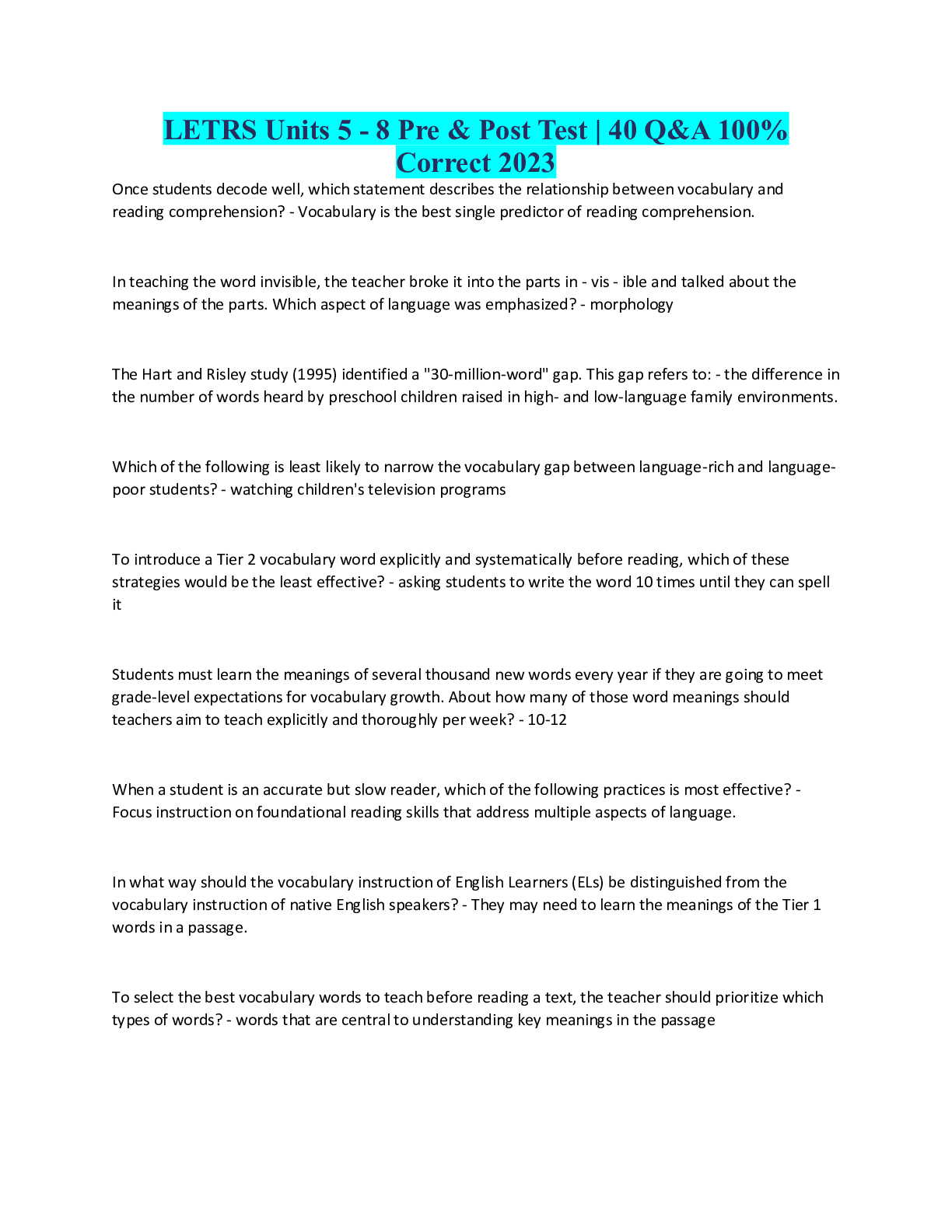
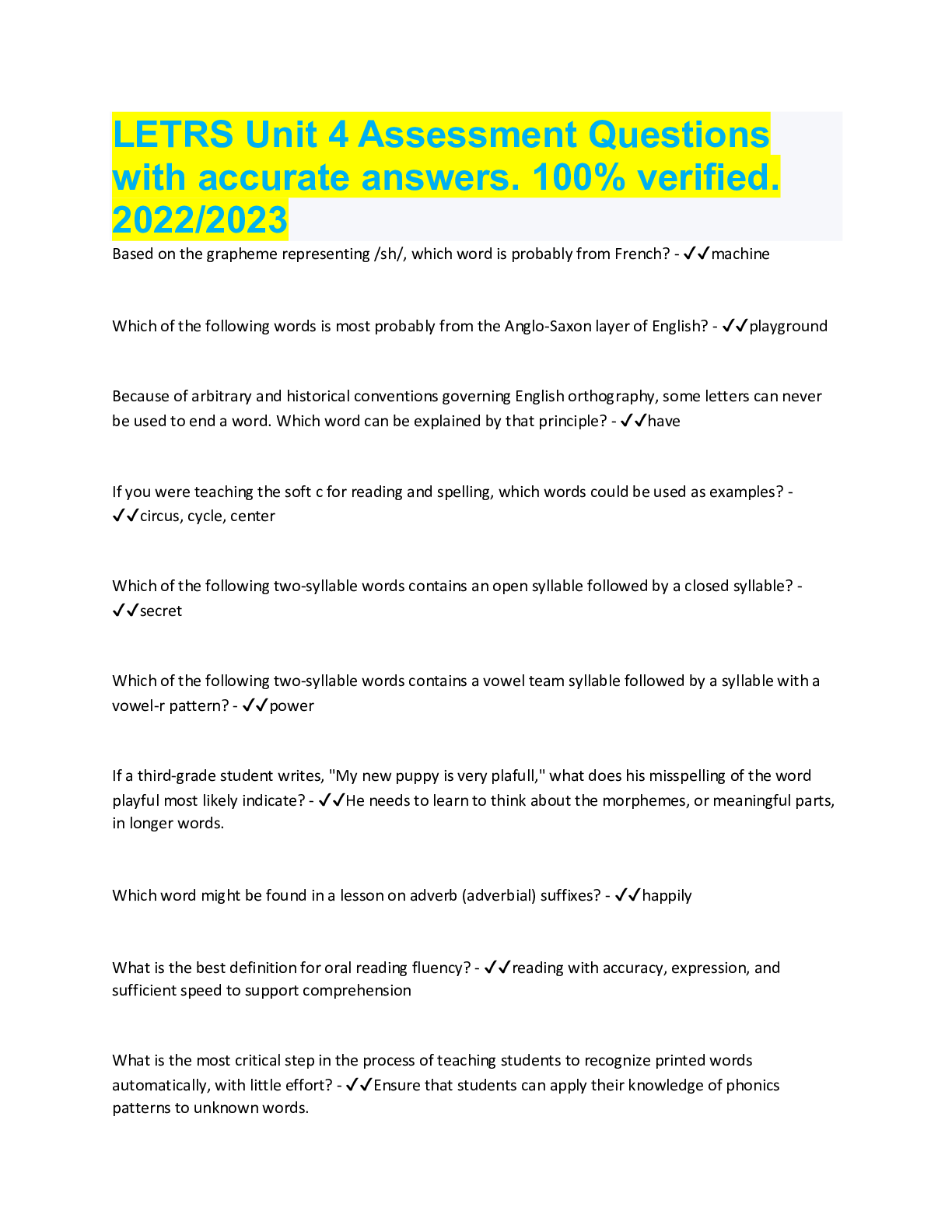
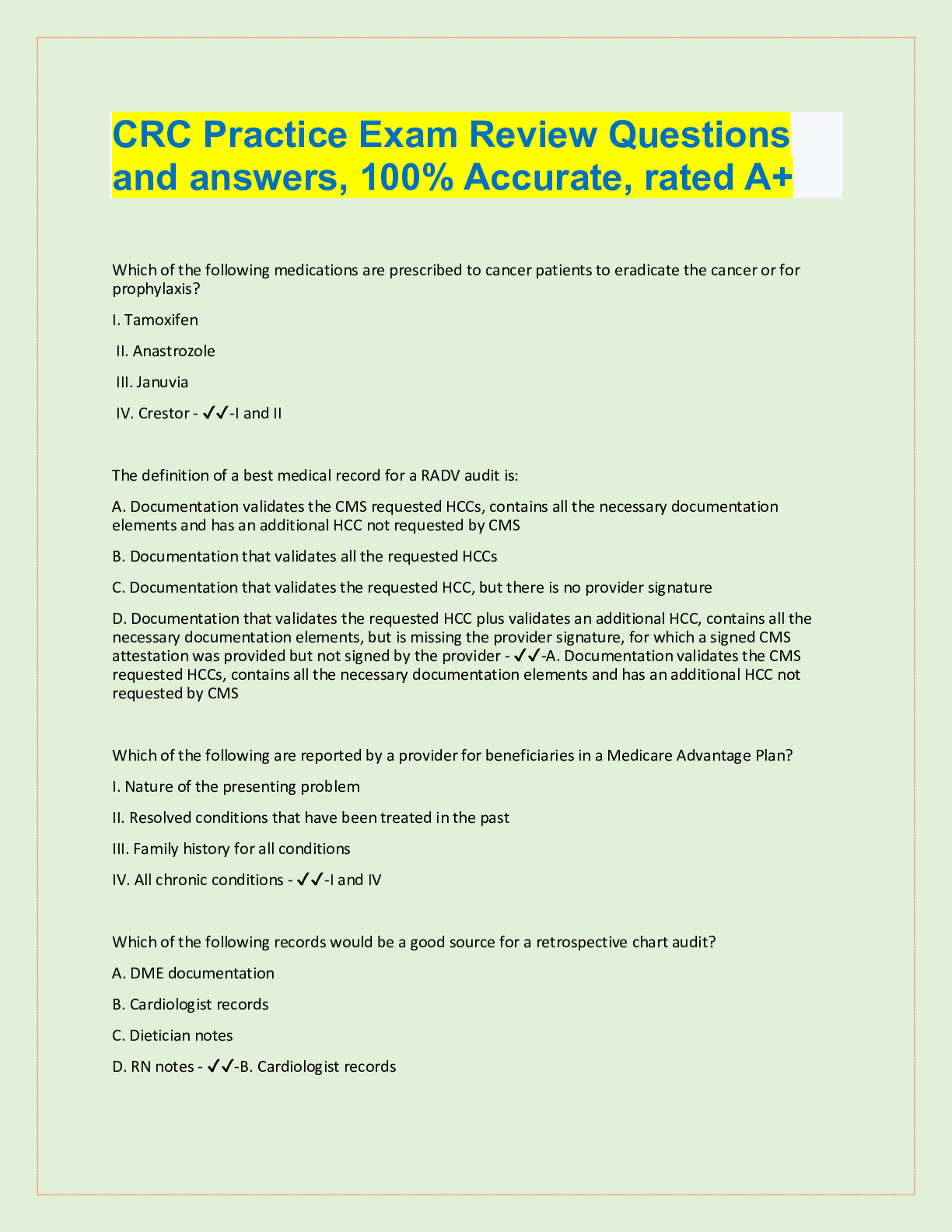

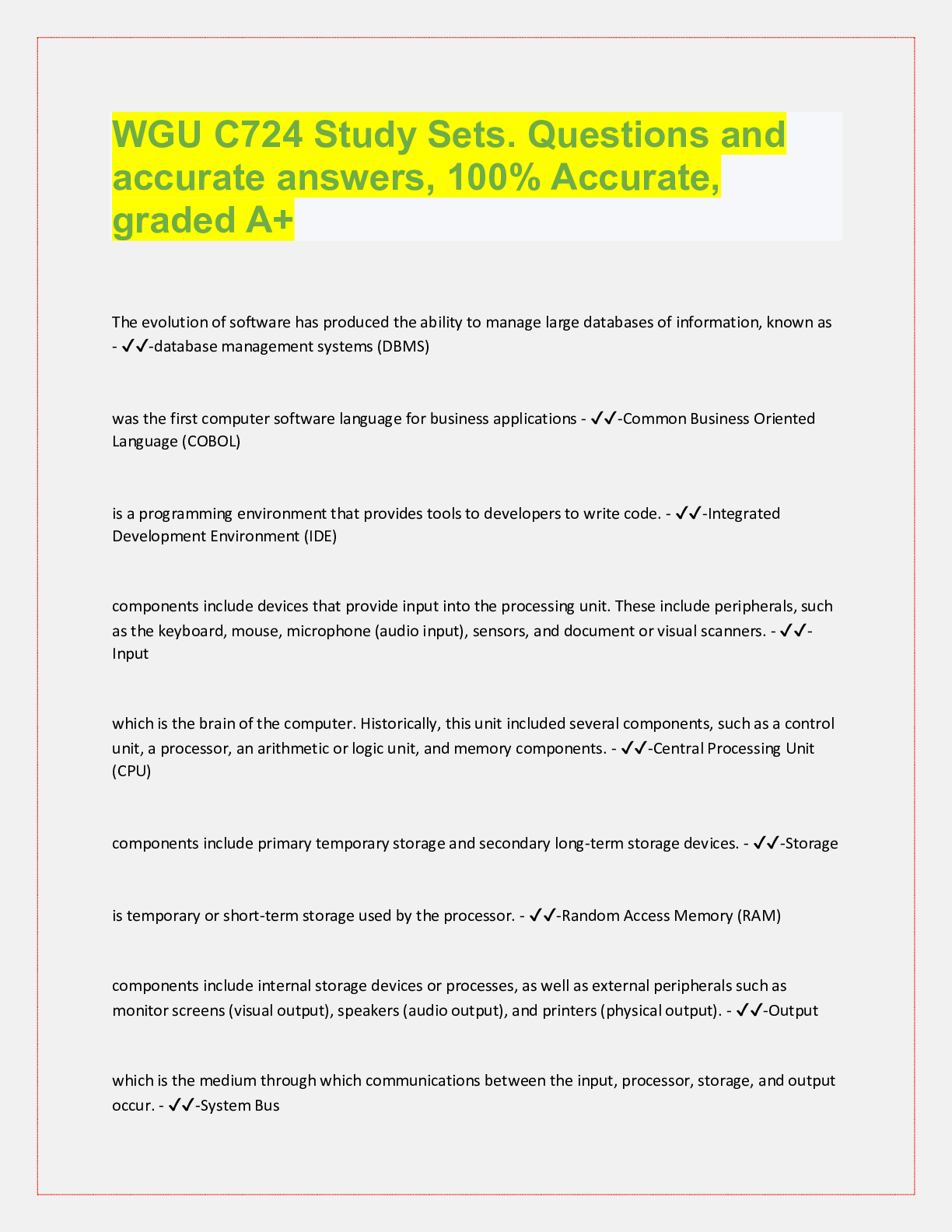


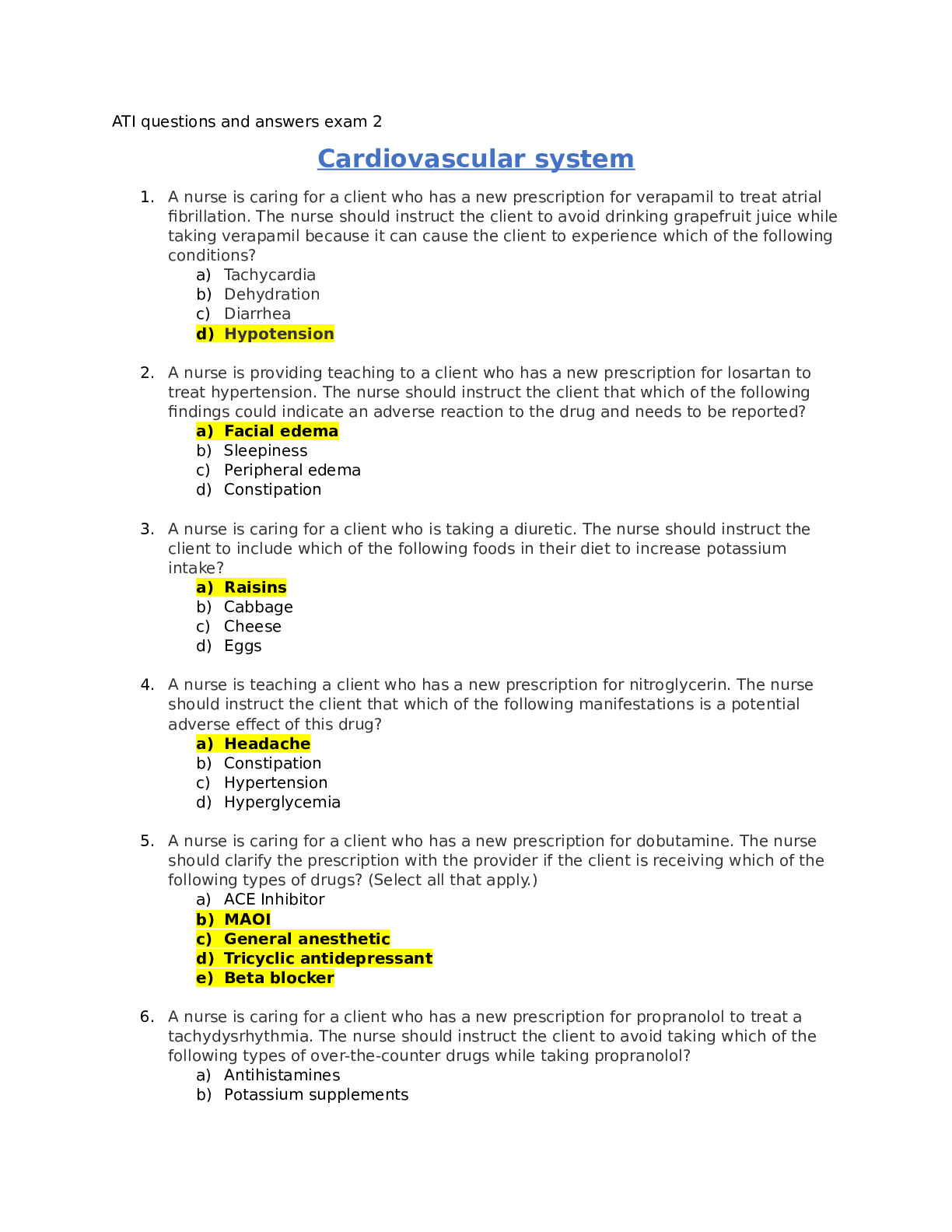
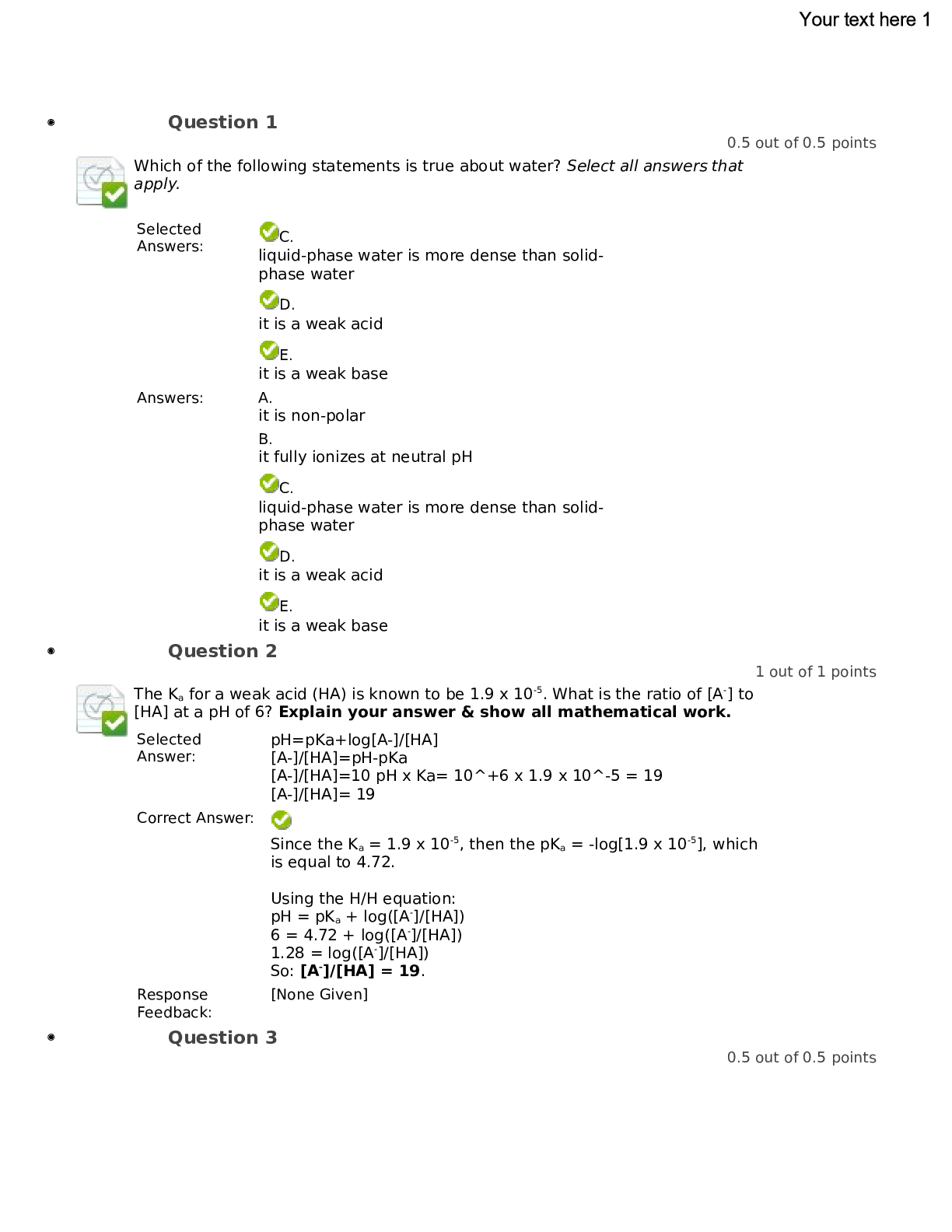
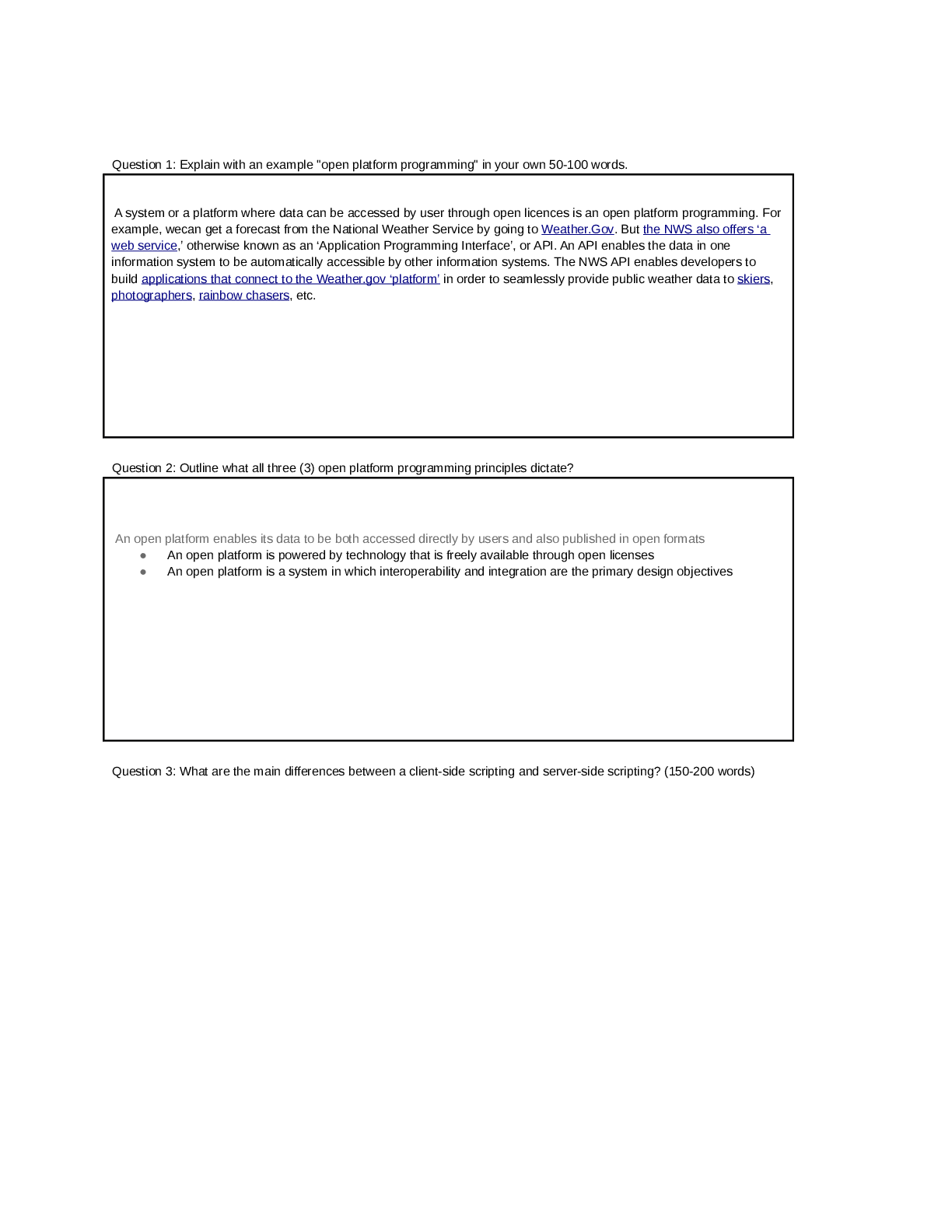
, Question Answers, Correct , Correct Answers.png)
.png)

, Question Answers, 100% Correct , Correct Answers.png)

